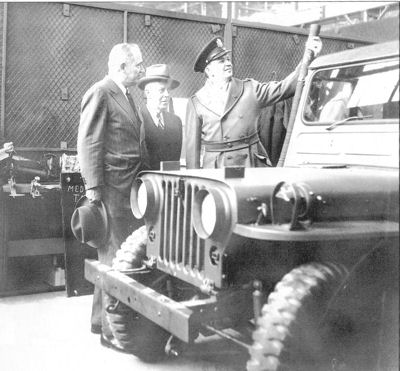
Photo from All-American Wonder Vol. III
by Fred W. Crismon
Home | Site Map | Contact Information
M-38
Pilot Models

Photo from All-American Wonder Vol. III
by Fred W. Crismon
NEW 1/1/2009
In the time since this web-page was published some new photos of the
Pilot Models have surfaced. The photos reveal that the pilot models
were in a constant state of change as different features were
implemented
and tested. The new information shows that some previous assumptions
are no longer valid. See the MVPA's magazine Army Motors #126 for the latest information.
By the end of the 1940s the US Army
was
ready to
start replacing its aging fleet of W.W.II jeeps. It had been nearly 5
years since the last MB rolled off the assembly line and some vehicles
were
approaching 10 years of service. Many had seen extreme use during
W.W.II, were then
reconditioned, and would also see service in Korea. As
popular as the
jeep was from the beginning, Willys-Overland and the Army continued to
experiment with
many
ideas for improvement. They tried to make it fly, turned it into a boat
and used it as a farm tractor. On June 6, 1949 a
contract for
new design military Jeeps was awarded to
Willys-Overland Motors, according to the Wall Street Journal.
This was probably contract
number W-20-089-ORD-4758 for 4000
units and spare
parts. It included 6 Pilot models and regular production M-38s
that were delivered though
very early in 1951. The Mansfield News Journal (Ohio)
reported that on December 15, 1949 Willys-Overland brought a "Pilot
model" Jeep to the Detroit Arsenal for inspection by Army Ordinance
Officials. This Jeep
incorporated many new features developed at
the request of the armed forces after studying reports on performance
of combat vehicles. It was tested under the supervision of
Willys-Overland's first vice president, Delmar G. Roos. The photo above
was taken on December 22, 1949 with Delmar Roos on the left, and an
Army Colonel on the right, standing behind what is likely to be this
Pilot model. Some major improvements over the W.W.II jeep were a 24
volt
electrical system, deep water fording capability, and commonality of
components with other tactical vehicles. There were also provisions for
quick starting in extremely cold weather and the entire powerplant
assembly could be removed without so much as draining any fluids. The
Traverse City Record-Eagle (Michigan) stated that "Six pilot models of
the new jeep will be delivered to the army shortly after Jan. 1, 1950
for 60 day tests." The six Pilot models were referred to as MC-38
by Willys in the Maintenance Manual that was
published specifically for them. This
vehicle would evolve into the M-38 after many minor refinements were
made.
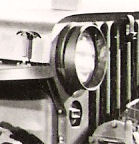
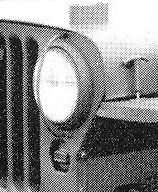

| Another unique Pilot model
feature is the axle vent plumbing. Both axle housings were connected to
the underwater ventilation
system along with the other gearboxes and reservoirs. Some of the
fittings and
lines inside the right frame rail can be seen in
the photo to the right. The vent system was connected to
the air filter housing to reduce water intrusion
when submerged. Strangely, in production the axle housing portion of
the ventilation
plumbing was eliminated and replaced by simple check valve fittings at
each axle. Also visible in the photo is the chaff deflector
portion of the
front propeller shaft guard. These front and rear propellor shaft
guards did not make it to production either. It is likely that many of
these new features were omitted to lower the final price, as was the
full floating rear axle. |
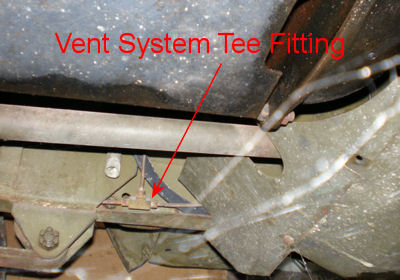 |
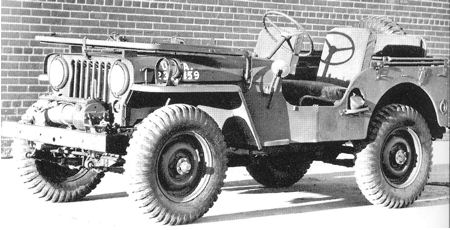 |
Hood number 2368159 has a large winch fitted; it looks similar to a Ramsey. Also seen are Vertical bar headlight guards, a fuel filler guard, left side blackout drive lamp and screws on the side of the hood for a grease gun mounting bracket. There are no body side drain holes. |
No photo available |
Hood number 2368160 |
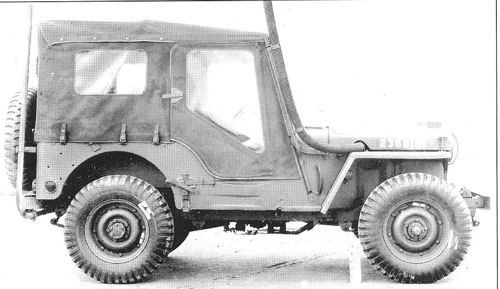 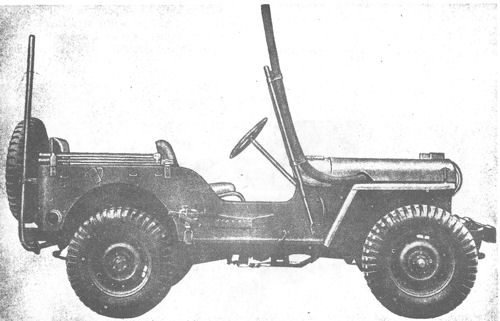 |
Hood number 2368161 does not have a winch. The slave cable receptacle is mounted in the right front wheelwell area where it could easily get covered with mud. This Pilot model has Vertical bar headlight guards and front lifting shackles but there are no side drain holes in the body. The second image appears to be a retouched photo of the same Jeep without the canvas top. |
No photo available |
Hood number 2368162 |
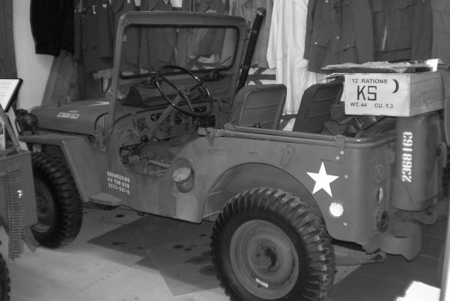 |
Apparently hood
number 2368163 was never delivered to the Army. It has a Braden capstan
winch, slave
cable receptacle mounted in right
front wheelwell area, Can type headlight guards, drain holes are in the
floor not in the side of the body, threaded front axle hub covers,
blackout driving
lamps on both front fenders, a
grease gun mounting
bracket mounted to the hood and has lifting shackles.
Absent is a fuel filler
guard. |
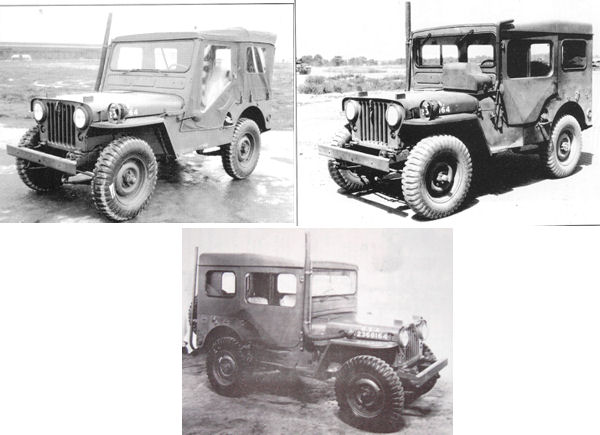 |
Hood number 2368164 has the slave cable receptacle mounted on the top of the fender but not recessed like the prototype model. There are no side drain holes, but it does have lift shackles, Vertical bar head light guards, fuel filler guard, screws on the side of the hood where a grease gun mounting bracket is installed. |
Apparently some Pilot models were used by the Army for testing purposes even after regular M-38 delivery started. This is evidenced by the 3 photos of 2368164 (above) showing the same vehicle in different configurations.
| To the right are additional
Pilot model photos.
Unfortunately there are no hood numbers visible so we don't know which
vehicle they are. One Jeep has a Gar
Wood winch but no lifting shackles, unlike the previous Gar Wood winch
equipped Jeep. The lower Jeep certainly looks
well used judging by worn tires and scuffed front bumper. It is unique
in that it has
a Ramsey model
50 winch mounted. The model 50 is
smaller and lighter than most of the other winches that were
tested and was selected as the winch to be
factory installed on M-38s. |
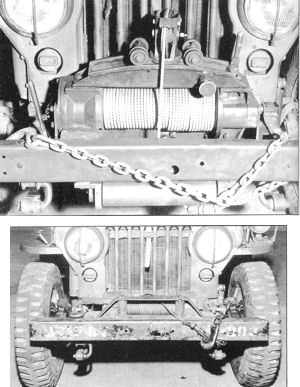 |
The CJ-3A Story | CJ-3A
Photos | CJ-3A Specs and Tech Tips | CJ-3A Literature | Siblings of the CJ-3A | Accessories | Links